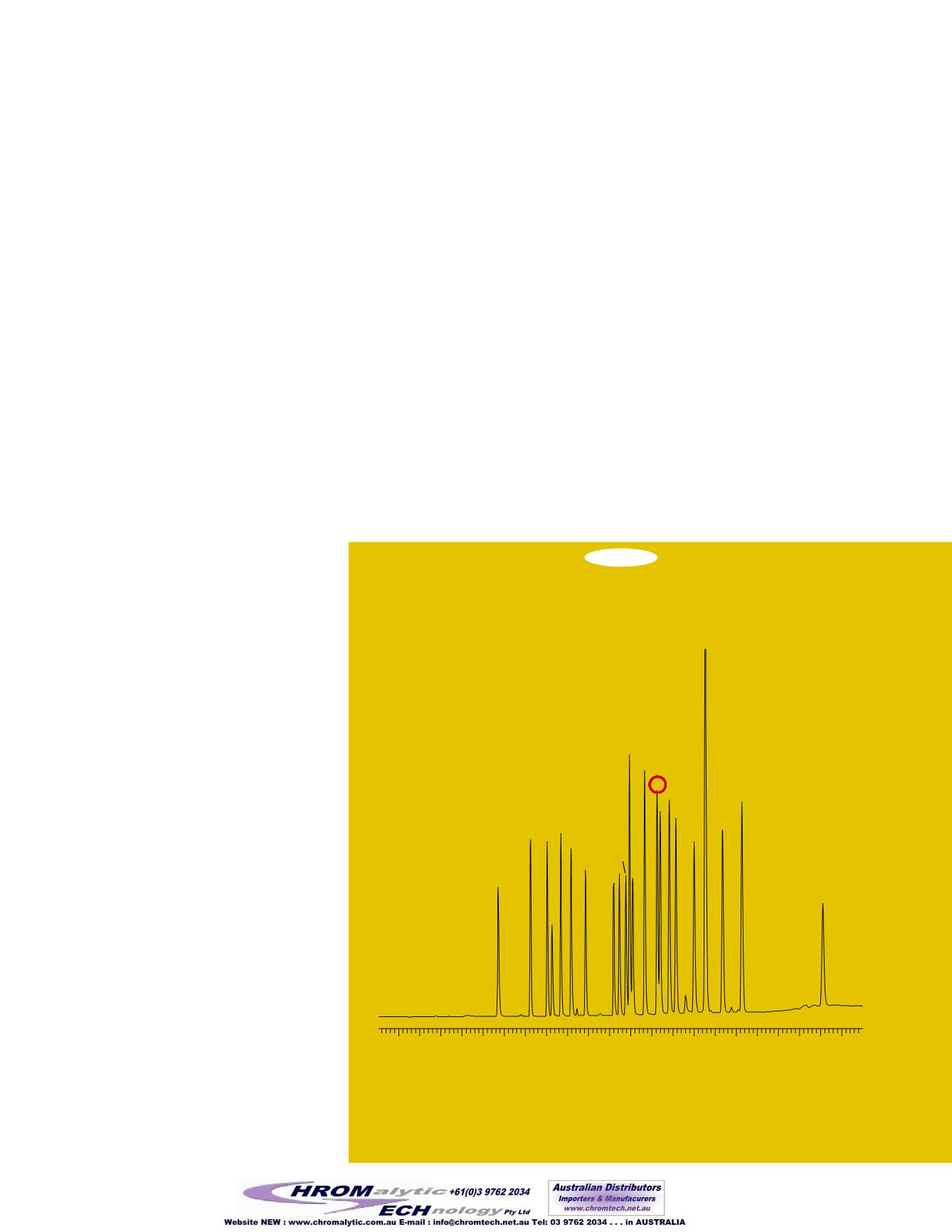

• 8 •
www.restekcorp.com800-356-1688
Many laboratories performing gas chromatography
(GC) analysis of chlorinated pesticides struggle with
endrin breakdown caused by the compound adsorb-
ing to active sites throughout the analytical system,
especially in the injection port and the analytical
column. Restek Siltek
™
technology—used success-
fully to passivate injection port liners and guard
columns—is now available in Stx
™
-CLPesticides and
Stx
™
-CLPesticides2 capillary columns. The combina-
tion of a properly deactivated injection system and
inert analytical columns provides the lowest possible
level of endrin breakdown.
Method Requirements
Chlorinated pesticide analyses following US
Environmental Protection Agency (EPA) Methods
8081, 608, 505 and 508 recommend dual-column
confirmation using electron capture detection
(ECD). The most common analytes of interest are
analyzed in Figure 1. As in all analytical methods,
the instrument used for quantitative analysis must
be calibrated to ensure accurate results are report-
ed. For chlorinated pesticides this usually entails a
calibration curve of three to five points and check
standards injected at specified time intervals during
sample analysis. In addition, performance stan-
dards containing endrin are analyzed periodically
to ensure system inertness. Typically, endrin breaks
down to endrin aldehyde and endrin ketone when
there are active sites in the sample pathway, and
their presence must also be verified.
Endrin Breakdown
Maintaining a low breakdown level for endrin is
necessary for laboratories analyzing chlorinated pes-
ticides. Reduction of endrin breakdown generally
focuses on improving the inertness of the injection
port (see sidebar on page 9). Recently, liners treat-
ed with Siltek
™
deactivation were designed to pre-
vent endrin breakdown in the injection port. This
innovative deactivation technology also was incorpo-
rated into capillary guard tubing so that the entire
sample introduction pathway is as inert as possible.
by Lydia Nolan, Environmental Innovations Chemist, and
Gary Stidsen, Innovations Team Manager
Reduced Endrin Breakdown
for Chlorinated Pesticides
Analysis
Stx
™
-CLPesticides GC Column Pairs
✔
Siltek
™
-deactivated analytical columns decrease endrin breakdown.
✔
Same selectivity as Rtx
®
-CLPesticides column pairs—no modification
to analysis parameters.
✔
Flow adjustments improve separation.
Endrin Response
In addition to breakdown, endrin response can be
reduced by irreversable adsorption onto active sites
in the sample pathway. To minimize on-column
adsorption of endrin, we incorporated Siltek
™
deactivation technology into the analytical columns.
Figure 1
Highly inert Stx
™
-CLPesticides and Stx
™
-CLPesticides2 columns provide excellent response for
active pesticides such as endrin, DDT, and methoxychlor so you get accurate quantitation.
Combining Siltek
™
deactivation with the unique
selectivity of Restek CLPesticides phases results in
the new Stx
™
-CLPesticides and Stx
™
-CLPesticides2
columns, and a significant improvement in endrin
response compared to “Rtx” columns (Figure 1).
Using the Stx
™
-CLPesticides and Stx
™
-CLPesticides2
columns, the endrin peak response is now higher
than the analytes eluting in the same region—
something not seen consistently in columns using
traditional deactivations.
Column Installation and Optimizing
Resolution
The Stx
™
-CLPesticides2 column is the ideal confirma-
tional column to the Stx
™
-CLPesticides column. It
was designed to achieve resolution of the chlorinated
pesticides using the same flowrate and oven temper-
ature program. The columns can be installed in par-
allel using a universal Siltek
™
Press-Tight
®
“Y” con-
nector or a metal MXT
®
“Y” connector. This parallel
set-up reduces downtime caused by maintenance of
multiple injection ports. Additionally, these columns
can be installed in separate injection ports and
mounted in the same GC oven.
GC_EV00512
Oven temp.:
110°C (hold 1 min.) to 245°C @ 20°C/min. to 300°C @ 6°C/min.;
Inj. & det. temp.:
210°C / 310°C;
Carrier gas:
helium;
Dead time:
0.8min. @ 120°C;
Inlet liner:
Siltek
™
Uniliner
®
w/hole (cat.# 21055-214.5);
Inj.:
1µL direct injection of
20/40/200ng/mL std. concentration in hexane;
Make-up gas:
nitrogen
3
4
5
6
7
8
9
10
11
12
13
1
2 3
4
5
6
7
8
9
10
11
12
13
14
15
16
17
18
19
20
21
22
Stx
™
-CLPesticides
30m, 0.32mm ID, 0.5µm
(cat.# 11544)


















